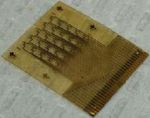A team consisting of Georgetown University‘s Georgetown Advanced Electronics Laboratory (GAEL) researchers, Science Applications International Corp. (SAIC), and Gentag, has finished development on a glucose measuring system that, once commercially available, would allow diabetics to monitor their glucose levels electronically—using an RFID-enabled cell phone—without needing to prick their fingers.
SAIC researchers worked with Georgetown University on the research and development of the glucose sensor technology, which has been tested thus far only on animals with the exception of Georgetown associate physics professor Mak Paranjape, who tested the system on himself. Gentag provided passive RFID technology. The companies are awaiting FDA approval for the commercial sale of glucose-monitoring products that use the RFID-based sensors. Because the technology is considered non-invasive, human testing would not be necessary. The companies are hoping to sign a licensing agreement with a company seeking to manufacture and distribute such a system, which Gentag president and CEO John Peeters predicts will be a popular alternative to the current painful and expensive glucose-testing methods being used by diabetics.
Diabetics have to keep a close eye on their blood sugar, requiring them to measure their glucose level anywhere from two times a day to every 15 minutes, depending on the type of diabetes they have, explains Paranjape, who shares a patent for the sensor technology with Georgetown University and SAIC. Typically, diabetic patients use a disposable lancet to prick a fingertip to draw blood and testing strips on which the blood is collected and tested. This costs about 75 cents per test, estimates Peeters. The pain and cost both tend to discourage many from testing as often as they should.
The solution developed by Paranjape with Gentag and SAIC centers on a skin patch containing a noninvasive sensor that can measure a person’s glucose level and transmit the result to a handheld reader or cell phone. The skin patch is similar in appearance to a Band-Aid, says Paranjape, with the actual sensor and battery as well as Gentag’s RFID chip and antenna incorporated inside.
The glucose sensor contains a tiny heating element powered by a small battery. Each time the sensor takes a glucose reading, the element warms to about 130 degrees Celsius for 30 milliseconds, burning through the outermost level of dead skin cells in spaces about the diameter of a human hair. The heated outer layer allows access to interstitial fluid beneath that layer, which the sensor then uses to assay the level of sugar. In this scenario, the user wouldn’t feel a thing, says Paranjape, who adds that he felt no pain when trying it on himself.

When a patient needs a reading, he can use his cell phone’s RFID reader to instruct the RFID chip that the sensor should send a new reading, or the system can be set to regularly transmit new readings for a predetermined number of times. The sensor can be used by itself because it includes a color metrics system that lights a tiny dot on its surface to indicate whether the glucose level is normal. However the colored dot is very small, so not easy to see or to interpret, Paranjape says, while the RFID system adds a layer of functionality in which users display a number indicating their exact glucose level at that moment and even send that data to a physician.
Gentag’s 13.56 MHz passive RFID tag is hardwired to the sensor and receives the results each time the sensor measures the user’s sugar level. An RFID interrogator complying with ISO standard 15693 can be used to download the glucose level when it is held within 2 inches of the sensor. If the test user has an RFID-enabled mobile phone, he can use it to receive the RF signal and then display the results of the test on the handset’s display screen. First the user would download the Gentag software on the phone, Peeters says, then it would display a sensor icon that the user could select to initiate a test and read the resulting data generated by the sensor.
Peeters says the three companies are in conversations with health-equipment manufacturers and distributors that might be interested in making products based on the researchers’ RFID-enabled glucose-sensing technology, and he hopes to have a licensing agreement with at least on of those companies within the next three months or so. He adds that he is also in discussions with the insurance industry, which is showing an interest in this method. He predicts that the low cost of the RFID- and sensor-based system would save its users about $350 a year if they tested their glucose level twice a day.
“E-visits are starting to be reimbursed by the U.S. insurance industry, and our view is that RFID-enabled cell phones combined with disposable wireless sensors form the perfect technology combination to allow secure low-cost self-monitoring of patients in the comfort of their homes,” Peeters says. “This will reduce the time spent in hospitals and therefore will reduce medical costs.” One of the RFID-enabled skin patches typically can be used for 100 different tests before it must be replaced with a new one.
More importantly, for patients who currently avoid monitoring their glucose level because of the pain involved in pricking their fingers, Gentag’s system would encourage patients to test more regularly. Peeters recalled speaking with a parent of a two-year-old diabetic who said she would like to try any alternative to pricking her child’s finger repeatedly every day.
If the users chose, he adds, they could use their phones to upload their glucose level to a physician’s e-mail address or Web site, where it could be tracked.
“We’re leveraging RFID technology to make medical diagnostics affordable, and there’s a great value in that,” Peeters says.




